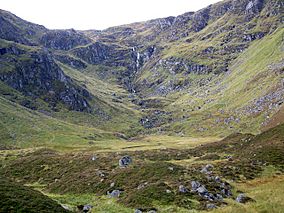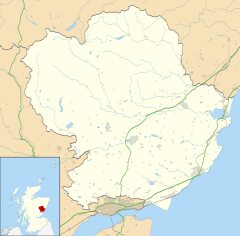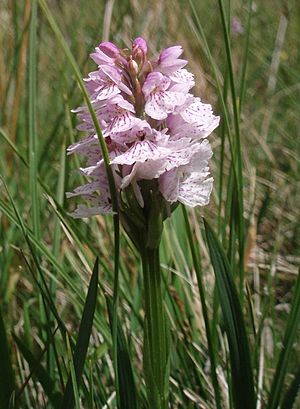Corrie Fee facts for kids
Quick facts for kids Corrie Fee National Nature Reserve |
|
|---|---|
|
IUCN Category IV (Habitat/Species Management Area)
|
|

The Corrie of Fee
|
|
| Location | Kirriemuir, Angus, Scotland |
| Area | 164 ha (410 acres) |
| Established | 2005 |
| Governing body | NatureScot |
| Corrie Fee National Nature Reserve | |
Corrie Fee is a special place in the Angus Glens of Scotland. It is a huge, bowl-shaped valley carved by glaciers. Imagine a giant scoop taken out of the mountainside! This amazing spot is part of the Corrie Fee National Nature Reserve (NNR).
The NNR is looked after by NatureScot, a Scottish nature agency. It is also inside the huge Cairngorms National Park. Corrie Fee is famous for being one of the best examples of a glacial valley in the British Isles. Its steep cliffs look like a natural outdoor theatre.
This reserve is home to many rare plants. Some of these plants are called arctic-alpine because they usually grow in very cold, high places. Corrie Sharroch, which is next to Corrie Fee, has the largest area of montane willow scrub in Scotland. Scientists have known how important these plants are since the 1700s. Because of this, the area is now protected by many national and international rules.
Contents
How Corrie Fee Was Formed: Geology and Glaciers
Corrie Fee has many different types of rocks. Deep below are rocks called Dalradian rocks. These rocks formed about 600 million years ago. This was when Scotland and North America were part of a huge continent that crashed into other continents.
Most Dalradian rocks are acidic. But at Corrie Fee, there are also some basic rocks. These basic rocks came from muddy, lime-rich dirt and volcanic material. They wear away easily and create soil rich in calcium. This special soil helps many lime-loving plants to grow. There are also rocks called amphibolite and other rock layers formed by hot liquid rock.
The Scottish Highlands, where Corrie Fee is, got its shape mostly during the last Ice Age. During a cold period called the Loch Lomond Readvance, small glaciers formed here. These glaciers were like giant bulldozers. They slowly moved, grinding away the bottom and sides of the valley. This created the steep, U-shaped cliffs you see today.
As the glaciers moved, they left behind piles of rock and dirt. These piles are called moraines. You can see different types of moraines on the floor of Corrie Fee. These moraines make the Fee Burn, a small stream, twist and turn a lot as it flows through the valley.
Amazing Plants and Animals
Corrie Fee National Nature Reserve has Scotland's biggest area of montane willow scrub. This rare habitat is found in Corrie Sharroch. It is one of the rarest and most endangered habitats in the UK. You can only find it in the higher parts of the Scottish Highlands.
This willow scrub is a leftover from the time after the Ice Age. It grows in damp, rich soil. However, animals like red deer and sheep like to eat these plants. So, the willows now mostly grow in places that are hard for animals to reach. These include rocky ledges or steep slopes. In 2009, people worried that the willows couldn't spread. So, Scottish Natural Heritage and the Royal Botanic Garden Edinburgh planted over 800 new willow shrubs.
Many other rare plants live at Corrie Fee. One is purple colt's-foot. This plant is common in places like Scandinavia, but it grows nowhere else in Britain. It was first noticed here in 1813. Other rare plants include yellow oxytropis, alpine blue sow-thistle, and two types of small ferns: alpine woodsia and oblong woodsia.
The reserve is also home to many mountain birds. You might see ring ouzels, peregrine falcons, twite, and ravens. In summer, swallows and house martins join them. Sometimes, Golden eagles can be seen hunting. Many mammals live here too. These include red deer, foxes, pine martens, moles, and different types of voles and mice.
Too many deer eating the plants can harm the rare plants. So, in 1991, a fence was put up around 60 hectares in Corrie Sharroch. People are also working to reduce the number of deer in the wider area. This helps protect the plants from being over-eaten.
Why Corrie Fee is Protected
Corrie Fee first became a National Nature Reserve in 1961. It was part of a much larger area called the Caenlochan NNR. In 1985, the Nature Conservancy Council bought 164 hectares of land at Corrie Fee and Corrie Sharroch. This agency later became Scottish Natural Heritage.
In 2000, the NNRs were reviewed. New rules now offered stronger protection for nature. So, in 2005, the NNR was made smaller and renamed Corrie Fee NNR. It now covers only the land owned by Scottish Natural Heritage. The International Union for the Conservation of Nature says Corrie Fee NNR is a Category VI protected area. This means it's a protected area where people can still use the land in a sustainable way.
The wider Caenlochan area still has other important protections. It is a Special Area of Conservation and a Site of Special Scientific Interest. It is also a Special Protection Area for birds that breed in the uplands. Another protection, the Cairngorms Massif, also covers the NNR.
Corrie Fee is also inside the Cairngorms National Park. It is part of the Deeside and Lochnagar National Scenic Area. These areas are protected because of their beautiful landscapes.
Visiting Corrie Fee
About 14,000 people visit the Corrie Fee National Nature Reserve each year. In 2008, a visitor centre was built at the end of the public road in Glen Doll. This centre was a team effort by Angus Council, Scottish Natural Heritage, the Cairngorms National Park Authority, and Forestry and Land Scotland.
From the visitor centre, a path follows the Fee Burn. It goes through Glen Doll Forest, which is owned by Forestry and Land Scotland. The path then leads to Corrie Fee. It continues up through the corrie to the top of the plateau. From the visitor centre to the top of the corrie is about 5 kilometres.
The path through Corrie Fee is a main way to reach the top of Mayar. Many people climb Mayar along with its neighbour, Dreish.
Corrie Fee is also a popular place for winter climbing. It has many short climbing routes. However, NatureScot has asked climbers to be careful in spring. Climbing then might disturb birds of prey that are nesting.




